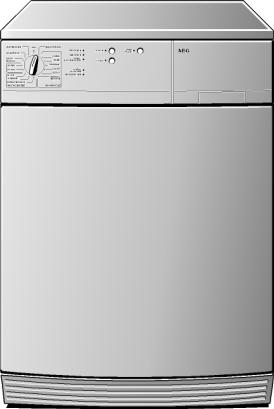AEG LAVATHERM 57320 User Manual

LAVATHERM 57320 electronic
Condenser Dryer
Operating Instructions

Dear customer,
Please read these operating instructions through carefully.
Please make sure you read the safety instructions on the first pages of these operating instructions! Keep the operating instructions for future reference. Pass them on to any future owners.
1 With the warning triangle and/or by means of key words (Danger!, Caution!, Attention!), information is emphasized which is important for your safety or the correct functioning of the appliance. It is essential that this information is observed.
0 This symbol guides you step by step when operating the appliance.
3 Next to this symbol you receive additional information and practical tips on using the appliance.
2 Tips and information about the economical and environmentally friendly use of the machine are marked with the clover.
•These operating instructions contain information about how to independently solve any problems which may arise. See "Something not working".
Printed on environmentally friendly paper ...
Whoever thinks ecologically also acts ecologically.
2

Content |
|
Important Safety Information . . . . . . . . . . . . . . . . . . . . . . . . . . . . . . . . . . . |
5 |
General Information . . . . . . . . . . . . . . . . . . . . . . . . . . . . . . . . . . . . . . . . . . . |
7 |
Disposal . . . . . . . . . . . . . . . . . . . . . . . . . . . . . . . . . . . . . . . . . . . . . . . . . . . . . . |
8 |
Packaging . . . . . . . . . . . . . . . . . . . . . . . . . . . . . . . . . . . . . . . . . . . . . . . . . . . . . |
8 |
Environmental protection tips . . . . . . . . . . . . . . . . . . . . . . . . . . . . . . . . . . |
9 |
The key features of your appliance . . . . . . . . . . . . . . . . . . . . . . . . . . . . . . |
11 |
Description of the appliance . . . . . . . . . . . . . . . . . . . . . . . . . . . . . . . . . . . . |
12 |
Front view . . . . . . . . . . . . . . . . . . . . . . . . . . . . . . . . . . . . . . . . . . . . . . . . . . . . . |
12 |
The program selector . . . . . . . . . . . . . . . . . . . . . . . . . . . . . . . . . . . . . . . . . . . . |
14 |
Before using the appliance for the first time . . . . . . . . . . . . . . . . . . . . . |
14 |
Brief instructions . . . . . . . . . . . . . . . . . . . . . . . . . . . . . . . . . . . . . . . . . . . . . . |
15 |
Drying . . . . . . . . . . . . . . . . . . . . . . . . . . . . . . . . . . . . . . . . . . . . . . . . . . . . . . . . |
16 |
Prepare the laundry . . . . . . . . . . . . . . . . . . . . . . . . . . . . . . . . . . . . . . . . . . . . . |
16 |
Open the door . . . . . . . . . . . . . . . . . . . . . . . . . . . . . . . . . . . . . . . . . . . . . . . . . |
16 |
Load the laundry . . . . . . . . . . . . . . . . . . . . . . . . . . . . . . . . . . . . . . . . . . . . . . . |
16 |
Closing the door . . . . . . . . . . . . . . . . . . . . . . . . . . . . . . . . . . . . . . . . . . . . . . . |
16 |
Select the drying program . . . . . . . . . . . . . . . . . . . . . . . . . . . . . . . . . . . . . . . |
16 |
Start the drying program . . . . . . . . . . . . . . . . . . . . . . . . . . . . . . . . . . . . . . . . |
18 |
Removing laundry or loading laundry when necessary . . . . . . . . . . . . . . . . |
18 |
End of the drying process . . . . . . . . . . . . . . . . . . . . . . . . . . . . . . . . . . . . . . . . |
18 |
Removing the laundry . . . . . . . . . . . . . . . . . . . . . . . . . . . . . . . . . . . . . . . . . . . |
18 |
Empty the water reservoir . . . . . . . . . . . . . . . . . . . . . . . . . . . . . . . . . . . . . . . |
19 |
Cleaning the door seal . . . . . . . . . . . . . . . . . . . . . . . . . . . . . . . . . . . . . . . . . . |
19 |
Clean the fluff filter . . . . . . . . . . . . . . . . . . . . . . . . . . . . . . . . . . . . . . . . . . . . |
20 |
Cleaning the condenser . . . . . . . . . . . . . . . . . . . . . . . . . . . . . . . . . . . . . . . . . |
21 |
Switch-off the dryer . . . . . . . . . . . . . . . . . . . . . . . . . . . . . . . . . . . . . . . . . . . . |
21 |
Program tables . . . . . . . . . . . . . . . . . . . . . . . . . . . . . . . . . . . . . . . . . . . . . . . . |
22 |
A small glossary of textile information . . . . . . . . . . . . . . . . . . . . . . . . . . . |
24 |
Care symbols . . . . . . . . . . . . . . . . . . . . . . . . . . . . . . . . . . . . . . . . . . . . . . . . . . |
24 |
3

Content
Cleaning and maintenance . . . . . . . . . . . . . . . . . . . . . . . . . . . . . . . . . . . . . |
25 |
Cleaning the condenser . . . . . . . . . . . . . . . . . . . . . . . . . . . . . . . . . . . . . . . . . |
25 |
Cleaning the filter area . . . . . . . . . . . . . . . . . . . . . . . . . . . . . . . . . . . . . . . . . . |
25 |
Cleaning the drum . . . . . . . . . . . . . . . . . . . . . . . . . . . . . . . . . . . . . . . . . . . . . . |
26 |
Cleaning the panel and operating parts . . . . . . . . . . . . . . . . . . . . . . . . . . . . |
26 |
Cleaning the door seal . . . . . . . . . . . . . . . . . . . . . . . . . . . . . . . . . . . . . . . . . . |
26 |
Something not working? . . . . . . . . . . . . . . . . . . . . . . . . . . . . . . . . . . . . . . . |
27 |
Replace the interior light . . . . . . . . . . . . . . . . . . . . . . . . . . . . . . . . . . . . . . . . |
29 |
Door Reversal Instructions . . . . . . . . . . . . . . . . . . . . . . . . . . . . . . . . . . . . . . |
30 |
Technical data . . . . . . . . . . . . . . . . . . . . . . . . . . . . . . . . . . . . . . . . . . . . . . . . |
32 |
Installation and electrical connection . . . . . . . . . . . . . . . . . . . . . . . . . . . . |
32 |
Information for the electrician . . . . . . . . . . . . . . . . . . . . . . . . . . . . . . . . . . |
32 |
Special accessories . . . . . . . . . . . . . . . . . . . . . . . . . . . . . . . . . . . . . . . . . . . . . |
33 |
Drainage kit . . . . . . . . . . . . . . . . . . . . . . . . . . . . . . . . . . . . . . . . . . . . . . . . . . . |
33 |
Stacking kit . . . . . . . . . . . . . . . . . . . . . . . . . . . . . . . . . . . . . . . . . . . . . . . . . . . |
33 |
Content . . . . . . . . . . . . . . . . . . . . . . . . . . . . . . . . . . . . . . . . . . . . . . . . . . . . . . |
34 |
Service . . . . . . . . . . . . . . . . . . . . . . . . . . . . . . . . . . . . . . . . . . . . . . . . . . . . . . . |
35 |
4

Important Safety Information
1Important Safety Information
The safety of AEG electrical appliances complies with the established technical principles and statutory equipment safety regulations. Nevertheless, as manufacturer we have to draw your attention to the following safety instructions.
General safety
•Repairs of the dryer may be carried out only by trained personnel. Incompetently carried out repairs can entail considerable hazards for the user. Please get in touch with our customer service or with an authorised AEG dealer when repair is necessary.
•Before commencing operation please make sure that the nominal voltage and type of supply specified on the type plate of the appliance correspond to the actual nominal voltage and supply type at the place of utilisation. The fuse rating is also specified on the type plate.
•Never operate the dryer when the mains cable is damaged or when the operator control mask, work plate or base shrouding are damaged such that there is direct access to the interior of the appliance.
•Switch-off the dryer before carrying out any cleaning, care and maintenance tasks! You are quite safe if you disconnect the mains plug from the power outlet or – if the electrical connection is permanent – if you switch-off the circuit breaker in the fusebox or screw the fuse cartridge right out of its holder.
•Never pull on the cable to disconnect the mains plug from the power outlet. Always grasp and pull-out the plug.
•Don’t lean on the opened door; this could make the appliance fall over.
•Don’t use a water jet to spray-down the appliance. Danger of electric shock!
•The covering hood for the filament lamp bulb for drum illumination must be screwed-on.
•When closing the door, please check that the washing is not caught in it.
•If you interrupt the drying process to take out laundry, bear in mind that the laundry and the drum could be hot.
•Adaptors and extension cables must not be used. There is risk of fire because of overheating!
5

Important Safety Information
Safety of children
•Children are often not aware of the dangers involved when handling electrical equipment. Therefore provide the necessary supervision of children when operating the appliance and do not let children play with the dryer – there is a danger that children could become trapped inside the appliance.
•Packaging parts (e.g. films, styropore) can be dangerous for children. Danger of suffocation! Keep packaging parts out of reach of children.
•Make sure that children or small animals do not climb into the drum of the dryer. For this purpose keep the door of the dryer closed when the appliance is not in use.
Utilisation in accordance with the intended purpose
•Conversions or modifications of the dryer are forbidden for safety reasons.
•Use the dryer only to dry ordinary household laundry! The manufacturer accepts no liability for any damage resulting from incorrect operation or utilisation for an unintended purpose.
•Dry only laundry which has been washed in water. In particular, textiles which have been treated with inflammable cleaning agents and solvents (petrol-ether, alcohol, stain remover and similar materials) must not be dried in the dryer. Danger of fire! Explosion hazard!
•Laundry items containing sponge rubber or rubber-like materials must not be dried in the dryer. Danger of fire!
•Washing that is in poor condition (heavily worn) and items with loose fillings (cushions) that could break open must not be dried or refreshed. There is a risk of fire!
•Washing with rigid components (foot mats) will cover the air slots; the slots will also be covered if the drum is overfilled. Observe the maximum load of 5 kg. There is a risk of overheating which could cause a fire!
•Only dry washing that does not contain any explosive objects (fire lighters, spray cans). There is a risk of fire or an explosion!
•Clean the fluff filter after each drying procedure.
•Clean the condenser regularly.
•In the case of washer / dryer tower combinations, do not place any objects on the dryer during use as they could drop down.
6

General Information
Installation and connection
•Check the dryer for Transportation damage. Never connect-up a damaged appliance! Contact your supplier if the appliance is damaged.
•If the tumble dryer has to be carried, first remove the plinth!
•Do not set-up the dryer in frost-endangered rooms!
•Set-up the dryer horizontal!
•If the dryer is placed adjacent to a gas, coal or electric cooking stove, interpose a thermally insulating non-combustible plate between the dryer and the stove (dimensions: 85x57,5cm).
•Do not place the dryer on high-pile carpet floors!
This would hinder air circulation at the ventilation slots!
•The electric power plug connector of the appliance must remain accessible even after erection.
•Check that the tumble dryer is not standing on the mains cable.
•The technical conditions of the electric power supply company for making fixed connections of electrical appliances to the mains require that such connections may only be made by an authorised electrician.
3 General Information
•Starched washing leaves traces of starch on the drum and therefore should not be placed in the tumble dryer.
•If you exceed the maximum load stipulated in the program table your washing is more likely to get creased! For very delicate fabrics you should only fill in 1.5kg washing at the most.
•For your information: 70 per cent of fabric wear is caused by being worn, 20 per cent by washing and only 10 per cent by being dried in a tumble dryer. As the fabric is worn down, fluff gathers in the fluff filter. When using a tumble dryer, only approx. 0.03g fluff per kilogramme washing is produced.
7

Disposal
2 Disposal
Packaging
Dispose of the packaging material!
Dispose of the packaging material of your tumble dryer correctly. All the packaging materials used are harmless to the environment and can be recycled.
• Plastic parts are marked with standard international abbreviations:
– >PE< |
for polyethylene, e.g. sheet wrapping material |
– >PS< |
for polystyrene, e.g. padding material (always CFC-free) |
– >POM< |
for polyoxymethylene, e.g. plastic clips |
Cardboard packaging is manufactured from recycled paper and should be deposited in the waste paper collection for recycling.
Disposal of the old appliance!
When you eventually stop using your tumble dryer please bring it to the nearest recycling centre or to your dealer who will take it back for a small fee.
1 Warning! When disposing of the tumble dryer, pull out the plug, cut off the flex, dispose of the plug and remaining flex and destroy the door lock. This hinders children from locking themselves in and endangering their lives.
The materials can be recycled in accordance with their markings. Standard tools (crosshead screwdriver, hammer) are sufficient to dismantle the old appliance.
8

Environmental protection tips
2 Environmental protection tips
•Your laundry will become light and soft in the tumble dryer even without a fabric softening agent.
•Loosen your laundry before loading it into the dryer. This helps to prevent lengthy running times and creasing. Ensure your laundry is well spun.
•Remove as much water as possible from the washing before drying! This is based on the principle: the better you spin the washing before drying the more economical the dryer is.
In the following table we give an overview of specific electric consumption data depending on the spinning speed. This information is valid for 5kg laundry dried with the program COTTONS CUPBOARD DRY (KATOEN KAST-DROOG):
Spinning/wringing out: |
|
Drying cycle: |
||||
Revolutions per |
Residual dampness |
Time required in |
Energy requirement |
|||
|
|
|
||||
minute |
in litres |
|
in % |
minutes |
in kWh |
|
|
|
|
|
|||
800 |
3.5 |
|
70 |
90 |
3.5 |
|
|
|
|
|
|
|
|
1000 |
3.0 |
|
59 |
85 |
3,0 |
|
1200 |
2.7 |
|
53 |
75 |
2.7 |
|
1400 |
2.5 |
|
50 |
70 |
2.6 |
|
1600 |
2.2 |
|
44 |
65 |
2.5 |
|
|
|
|
|
|
|
|
•Never obstruct the ventilation slits at the base of the dryer!
•Ensure that the room is well ventilated!
•Observe the maximum load instructions. Whenever possible, dry full loads.
9

Environmental protection tips
•Select the appropriate drying program for the type and quantity of laundry. The dryer will then operate as economically as possible. Some typical consumption values:
|
Fill weight |
Duration in |
Power |
|
Drying program |
consumption |
|||
in kg |
Minutes |
|||
|
in kWh |
|||
|
|
|
||
COTTONS CUPBOARD DRY1 |
5 |
90 |
3.5 |
|
(KATOEN KAST-DROOG) |
||||
|
|
|
||
COTTONS HAND IRON1 |
5 |
70 |
2.8 |
|
(KATOEN STRIJK-DROOG b) |
||||
|
|
|
||
DELICATES CUPBOARD DRY2 |
2.5 |
35 |
1.3 |
|
(MENGWEEFSELS KAST-DROOG) |
||||
|
|
|
||
1) spun at 800 revolutions per minute |
|
|
|
|
2) spun at 1000 revolutions per minute |
|
|
|
If the amount of laundry is not enough for a particular degree of drying (e.g. HAND IRON; STRIJK-DROOG b), you should dry it in stages for best economy: Fill the dryer and select the program HAND IRON (STRIJK-DROOG b); after the end of this program take out your laundry for ironing. Finally dry the remaining laundry with the program CUPBOARD DRY (KAST-DROOG).
•Only use the SPECIAL CARE (LAGE TEMP.) button for loads up to 2.5kg.
•Clean the fluff filter after every drying program!
•Empty the water reservoir after every drying process!
You can use the collected condensed water as distilled water in the household, but first pour it through a paper filter bag.
1 Caution! The condensed water is not suitable for drinking or for use with foodstuffs.
• Clean the condenser regularly!
The dryer will operate more economical ly if you clean the condenser regularly.
10

The key features of your appliance
The key features of your appliance
•Program or time setting via the program selector
•SPECIAL CARE (LAGE TEMP.) button for gentle drying of sensitive fabrics
•AUDIBLE SIGNAL (ZOEMER) can be selected in addition; an intermittent audible signal is sounded after the end of the program.
•Program run display
11
